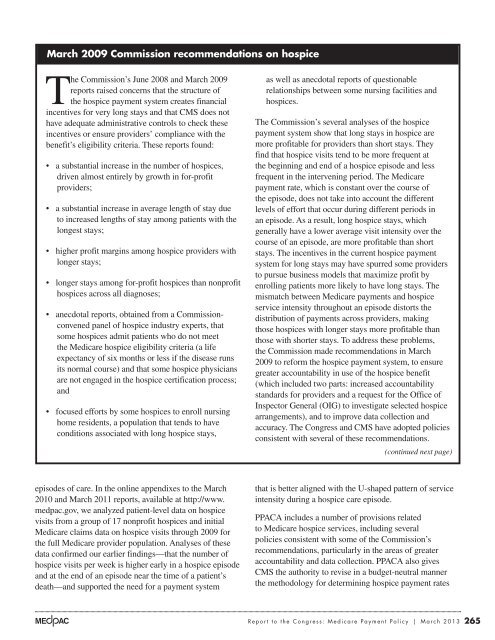Medicare Payment Policy
Medicare Payment Policy
Medicare Payment Policy
You also want an ePaper? Increase the reach of your titles
YUMPU automatically turns print PDFs into web optimized ePapers that Google loves.
March 2009 Commission recommendations on hospice<br />
The Commission’s June 2008 and March 2009<br />
reports raised concerns that the structure of<br />
the hospice payment system creates financial<br />
incentives for very long stays and that CMS does not<br />
have adequate administrative controls to check these<br />
incentives or ensure providers’ compliance with the<br />
benefit’s eligibility criteria. These reports found:<br />
• a substantial increase in the number of hospices,<br />
driven almost entirely by growth in for-profit<br />
providers;<br />
• a substantial increase in average length of stay due<br />
to increased lengths of stay among patients with the<br />
longest stays;<br />
• higher profit margins among hospice providers with<br />
longer stays;<br />
• longer stays among for-profit hospices than nonprofit<br />
hospices across all diagnoses;<br />
• anecdotal reports, obtained from a Commissionconvened<br />
panel of hospice industry experts, that<br />
some hospices admit patients who do not meet<br />
the <strong>Medicare</strong> hospice eligibility criteria (a life<br />
expectancy of six months or less if the disease runs<br />
its normal course) and that some hospice physicians<br />
are not engaged in the hospice certification process;<br />
and<br />
• focused efforts by some hospices to enroll nursing<br />
home residents, a population that tends to have<br />
conditions associated with long hospice stays,<br />
episodes of care. In the online appendixes to the March<br />
2010 and March 2011 reports, available at http://www.<br />
medpac.gov, we analyzed patient-level data on hospice<br />
visits from a group of 17 nonprofit hospices and initial<br />
<strong>Medicare</strong> claims data on hospice visits through 2009 for<br />
the full <strong>Medicare</strong> provider population. Analyses of these<br />
data confirmed our earlier findings—that the number of<br />
hospice visits per week is higher early in a hospice episode<br />
and at the end of an episode near the time of a patient’s<br />
death—and supported the need for a payment system<br />
as well as anecdotal reports of questionable<br />
relationships between some nursing facilities and<br />
hospices.<br />
The Commission’s several analyses of the hospice<br />
payment system show that long stays in hospice are<br />
more profitable for providers than short stays. They<br />
find that hospice visits tend to be more frequent at<br />
the beginning and end of a hospice episode and less<br />
frequent in the intervening period. The <strong>Medicare</strong><br />
payment rate, which is constant over the course of<br />
the episode, does not take into account the different<br />
levels of effort that occur during different periods in<br />
an episode. As a result, long hospice stays, which<br />
generally have a lower average visit intensity over the<br />
course of an episode, are more profitable than short<br />
stays. The incentives in the current hospice payment<br />
system for long stays may have spurred some providers<br />
to pursue business models that maximize profit by<br />
enrolling patients more likely to have long stays. The<br />
mismatch between <strong>Medicare</strong> payments and hospice<br />
service intensity throughout an episode distorts the<br />
distribution of payments across providers, making<br />
those hospices with longer stays more profitable than<br />
those with shorter stays. To address these problems,<br />
the Commission made recommendations in March<br />
2009 to reform the hospice payment system, to ensure<br />
greater accountability in use of the hospice benefit<br />
(which included two parts: increased accountability<br />
standards for providers and a request for the Office of<br />
Inspector General (OIG) to investigate selected hospice<br />
arrangements), and to improve data collection and<br />
accuracy. The Congress and CMS have adopted policies<br />
consistent with several of these recommendations.<br />
(continued next page)<br />
that is better aligned with the U-shaped pattern of service<br />
intensity during a hospice care episode.<br />
PPACA includes a number of provisions related<br />
to <strong>Medicare</strong> hospice services, including several<br />
policies consistent with some of the Commission’s<br />
recommendations, particularly in the areas of greater<br />
accountability and data collection. PPACA also gives<br />
CMS the authority to revise in a budget-neutral manner<br />
the methodology for determining hospice payment rates<br />
Report to the Congress: <strong>Medicare</strong> <strong>Payment</strong> <strong>Policy</strong> | March 2013<br />
265


